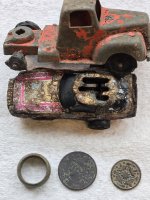Michigan Badger
Gold Member
In my opinion, this really is a GREAT subject and it never really seems to get it's just attention. To this day I've not found any conclusive scientific study data in regard to this issue.
To be frank (I'm really Badger), I think the depth of any lost object is determined by many known and unknown LOCAL factors. That is, I no longer believe it's so much about DOES an item sink or rise--but rather it's all about WHY are lost objects found at a certain depth at a certain location?
The WHY is really the important thing because this WHY tells me how to hunt for the other potential finds in that area.
Examples:
One major WHY is landfill and another could be low ground that catches the run-off from higher ground. Yet another could be a sandy area subject to extreme sand moving winds. And finally, another WHY could be plowing.
I've found that in some areas items go deeper and deeper over time (ancient dig sites). The WHY for this usually is caused by run-off or wind driven sands.
Here in Michigan I hunt fields that have probably never been plowed. The land was cleared for the storage of logs and building of houses. Today these fields are covered with very tall thick grass and the coins can be 150 years old and 1 inch deep. Most are usually 3 to 4 inches deep. I've dug early 19th century tools just barely under the surface.
The WHY is no nearby hills for run-off or sand to blow. Also, no traffic on the surface to drive items deep during muddy weather.
What about very old items laying on the surface? This week I found a 170+ year old iron knife laying on the surface. The WHY was it was in a water run-off area. The movement of water from rains kept this relic near the surface. This is one reason why one should always hunt sloping areas near low ground known to produce finds.
Now if anyone bothered to read all this thanks!
To be frank (I'm really Badger), I think the depth of any lost object is determined by many known and unknown LOCAL factors. That is, I no longer believe it's so much about DOES an item sink or rise--but rather it's all about WHY are lost objects found at a certain depth at a certain location?
The WHY is really the important thing because this WHY tells me how to hunt for the other potential finds in that area.
Examples:
One major WHY is landfill and another could be low ground that catches the run-off from higher ground. Yet another could be a sandy area subject to extreme sand moving winds. And finally, another WHY could be plowing.
I've found that in some areas items go deeper and deeper over time (ancient dig sites). The WHY for this usually is caused by run-off or wind driven sands.
Here in Michigan I hunt fields that have probably never been plowed. The land was cleared for the storage of logs and building of houses. Today these fields are covered with very tall thick grass and the coins can be 150 years old and 1 inch deep. Most are usually 3 to 4 inches deep. I've dug early 19th century tools just barely under the surface.
The WHY is no nearby hills for run-off or sand to blow. Also, no traffic on the surface to drive items deep during muddy weather.
What about very old items laying on the surface? This week I found a 170+ year old iron knife laying on the surface. The WHY was it was in a water run-off area. The movement of water from rains kept this relic near the surface. This is one reason why one should always hunt sloping areas near low ground known to produce finds.
Now if anyone bothered to read all this thanks!
Amazon Forum Fav 👍
Upvote
0





